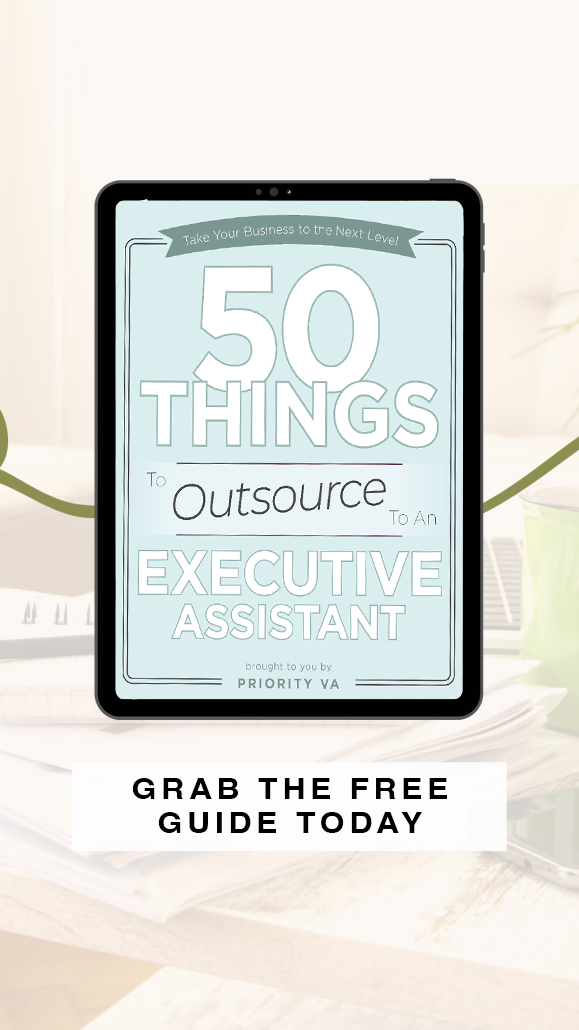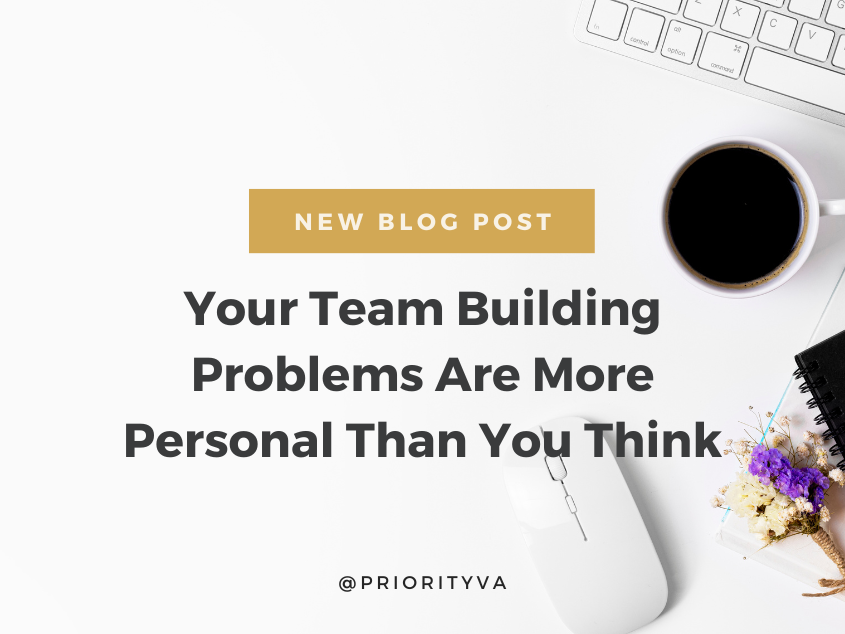“I am convinced that nothing we do is more important than hiring and developing people. At the end of the day you bet on people, not on strategies.” — Lawrence Bossidy, GE
The hiring process. We’ve found few things that frustrate a busy CEO or business owner more than the hiring process. It’s not something taught in business school and few people start their business because they have a passion for hiring!
CEOs build businesses because they have a fire in their heart for something….. an idea, a product, a service, that they know has to be out in the world, making it a better place.
But hiring? Most CEOs we polled dread it. It is time consuming and takes a special kind of expertise.
At Priority VA, we put over 66 years of combined experience together to build and refine a rock solid hiring process. We’re going to share that experience and our process here.
We are Kolbe Certified™ Consultants. What does that mean for our hiring process? Read on.
The Kolbe System™ is a revolutionary, proprietary analysis tool based on empirical research and years of experience. Its foundation is built on the fact that our “innate talents” are unchanging and constant. This is in stark contrast to our skills and learned abilities — which are in flux throughout our lives.
“The guessing game is over for people who use the Kolbe System. Studies show a correlation of over 90% between predicted and actual team success. Such predictive validity is dramatically higher with Kolbe than with any other technique or test.” — Ryan Thomas, Ph.D. Provost, Dean (retired) Weber State University
The Kolbe system identifies individuals through the unique ways in which they initiate solutions, respond to situations, and prevent problems. The Kolbe System has identified 12 instinctive methods of creative problem solving.
However, it’s important to note that one person’s approach is not deemed “better” than another. Rather, Kolbe studies have shown that having the right mix of individual types (or understanding the current mix) means greater productivity in the workplace — and better results no matter what the objective.
At the same time, Kolbe helps each individual to understand his or her inherent strengths — and how to use those strengths to better advantage in their personal and professional lives. The Kolbe System discusses the three parts of the mind and focuses on the least known, the Conative.
Three Parts of the Mind
Every day, we operate using three parts of the mind: the Cognitive, or thinking part, the Affective, or feeling part, and the Conative, or doing part.
The Cognitive part of the mind is what you can do, what you are capable of doing. It relates to:
- IQ
- Skills
- Reason
- Knowledge
- Experience
- Education
Common cognitive tests are the SAT or ACT, eSkills, and other intelligence tests. As we learn and grow over the course of our lifetime, the results of these tests change. We use eSkills to test candidates for cognitive skills required to perform the job they are being hired for.
The Affective part of the mind is what you want to do. It relates to:
- Desires
- Motivation
- Attitudes
- Preferences
- Emotions
- Values
Affective tests are better known as personality tests, such as Myers Briggs or Enneagram. As we grow and change over the course of our lifetime, the results of these tests change. We have used 16 Personalities, Myers Briggs, StrengthFinders, and Enneagram during our hiring process. These can add to the candidate’s profile but they do not paint the complete picture.
The Conative part of the mind is what you do and how you take action. It relates to:
- Drive
- Necessity
- Innate Force
- Instinct
- Mental Energy
- Talents
Kolbe Conative Indexes® identify and leverage instinct-based, or natural, abilities. It is the only validated assessment of the conative part of the mind.
Assessments have historically focused on measuring the cognitive (IQ) and the affective (personality) parts of the mind. While this can be helpful in selecting, training and managing people, they only offer a partial picture of a person’s full potential. IQ scores are influenced by opportunities to learn, and being smart doesn’t necessarily predict success. Personality traits are situational, and people who seem agreeable don’t always do a job successfully or accomplish team goals.
Understanding how instincts (conative) combine with intelligence (cognitive) and personality (affective)- all three parts of the mind – will help you create and maintain a less stressful work environment with employees who are more satisfied and productive:
- Identify the talent you have on board and the instinctive strengths they bring to the table
- Lead team members to achieve greater productivity and efficiency
- Hire More Effectively
Our hiring process is affectionately called The Hiring Gauntlet. Gauntlet was traditionally defined as, “a former punishment, chiefly military, in which the offender was made to run between two rows of men who struck at him with switches or weapons as he passed.”
While our Hiring Gauntlet is not punishment, it is not easy. Nor should it be. You will spend more time with your new hire than you do with your family. Who do you want in the ‘fox hole’ with you? Someone hired for their availability, affordability and interest? Or someone that has been thoroughly vetted, someone you know aligns with your company values, and someone who has been tested in all three parts of the mind? We know it is the latter.
Our process consists of three distinct phases:
• Prescreening
• Confirming Character
• Finalizing Your New Hire.
Prescreening Through Your Online Applicant Form
Stage 1 of the Hiring Gauntlet is the Online Application. This should include all the basic information you need on the candidate, including their skill self-assessment – what they say they can do. Testing their skills comes later. This stage should also include some non-negotiable, values-based, deal-breaker questions. If the candidate chooses the incorrect answer here, they do not move forward. We use and highly recommend JazzHR for this stage of prescreening, which can be completely automated.
Prescreening Through Your Elements of Fit Assessment
Stage 2 of the Hiring Gauntlet is the Elements of Fit Assessment. These are the affective assessments. You will have the candidate answer questions that speak to their personality and character, passion and purpose. At this stage, we also ask for relevant personality assessments. We have used 16 Personalities, Myers Briggs, StrengthFinders, and Enneagram during our hiring process. These can add to the candidate’s profile but they do not paint the complete picture.
Prescreening Through Your Skills & Proficiency Tests
Stage 3 of the Hiring Gauntlet is the Skills and Proficiency Assessment. These are our cognitive assessments. Here we have the candidate take skills tests relevant to the position – we use eSkills.
This is where you test what the candidate said they could do in prescreening stage 1 versus what they can actually do.
Confirming Character With Face-To-Face Interview #1
“Hiring people is an art, not a science, and resumes can’t tell you whether someone will fit into a company’s culture.” — Howard Schulz, Starbucks CEO
The next two stages are interviews. We know from hard-earned experience that both are necessary.
Stage 4 is the Face-to-Face (or Zoom or Skype) Interview. The questions asked in this interview should be those that identify the cultural fit – the affective side – of a candidate. We ask hard ball questions like “How badly do you want this job and why?” mixed in with soft questions such as, “If we had one reason not to move forward with you, what would that be?” This interview is a great place to get to know your candidate since you already know their background and skills from the previous stages.
If a candidate is approved in this stage, they move on to the conative assessments. We use Kolbe RightFit™ software to conatively identify the best candidate for the role. As a part of RightFit, the Supervisor and current top performers in the job (if any) take the Kolbe A™ Index to identify their methods of operation (MO). Supervisors also complete the Kolbe C™ Index which identifies their requirements for the job.
We use the Kolbe Index results to create a Kolbe Range of Success™ report which displays the instinctive problem-solving characteristics required for success in the role.
Any candidate that is approved through the Face-to-Face interview will take the Kolbe A™ Index and their results matched against the Kolbe Range of Success™ report. Candidates that show the appropriate skills through eSkills and fit into the Kolbe Range of Success™ are invited to proceed to the next phase and meet our client.
Confirming Character With The Third-Party Interview (Affective)
Stage 5 is a Third Party Interview. This is where we have our clients step in and be directly involved in the hiring process. This interview does not necessarily need to dwell on the candidates background or skills – we have confirmed those in Stage 3. This interview should confirm the character of your applicant through open-ended situational questions, more of the affective side of the candidate.
Confirming Character With Reference & Background Checks
Stage 6 is the traditional reference and background checks as applicable to the position. Do not skip this step, especially in the world of online business.
We can tell your horror stories of being wow’d by who someone claimed they worked for, and finding out a short time later that their claims were far from the truth. Do not skip this step.
Finalizing Your New Hire With Offer Letter & Negotiations
In Stage 7 you issue an offer letter and complete any negotiations necessary prior to employment.
This offer should include the pay rate, any benefits available, the start date, as well as terms of the position, if applicable. If your new hire will need to sign a Non-disclosure agreement, it is ideal to include that now.
Before issuing the offer, we suggest having “The Final Call.” The Final Call should be a short one. Less than 10 minutes.
This a chance to ask for any last-minute clarification questions or answer questions for the candidate about the role or to cover any areas of concern they might have.
Once the offer is issued and accepted, move on to finalizing your new hire.
Finalizing Your New Hire With Welcome & Onboarding
We have seen companies that had zero onboarding really struggle with getting their new hire up to speed on how the business and team members work. That’s why we created our 52-page Onboarding Success Kit. It contains checklists, profiles and templates to help you educate your new hire on the ins and outs of your business.
Using the Kolbe system “gives new hires deeper self-awareness and helps them contextualize their strengths into the new role and identify potential blind spots, laying the foundation for a quick and smooth transition.”
We use the Kolbe Indexes to do a Comparison A to A Report™. This report allows us to identify possible conative conflict between two people with differing strengths. We provide coaching to resolve any possible conflicts before they start and coach to recognize the individual needs of each person according to their mode of operation.
The Kolbe tool Activate Your A™️ Guide is another means of mentoring the new hire. This guide focuses on the new team members strengths, productivity, collaboration style and future. We provide the A to A Guide™ comparing A Indexes with their executive so we can coach through issues that pop up based on both MOs.
That’s it. And ‘it’ is a lot. The Hiring Gauntlet is intentionally a demanding process.
“People are not your most important asset. The right people are.” – Jim Collins, Author Good to Great
We want candidates to show they are willing to do the hard work to be a part of the team, as we know this will translate to doing hard work when they are ON the team.
If you’re ready to let us do the hard work of hiring for you, schedule a Free Strategy Call to get started today.
Trademarks and registered trademarks are the property of Kathy Kolbe and Kolbe Corp. All rights reserved. Used herein with permission.





